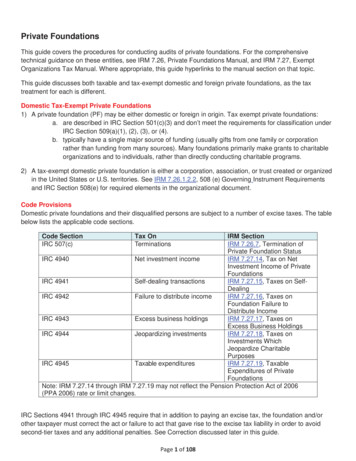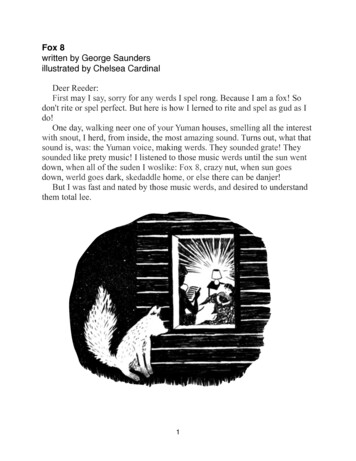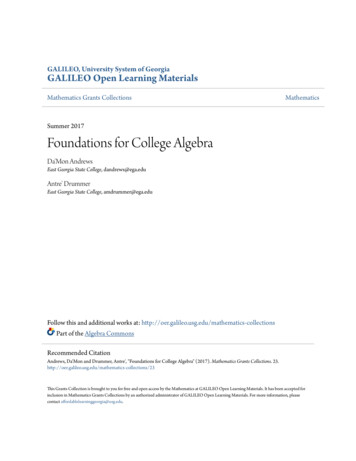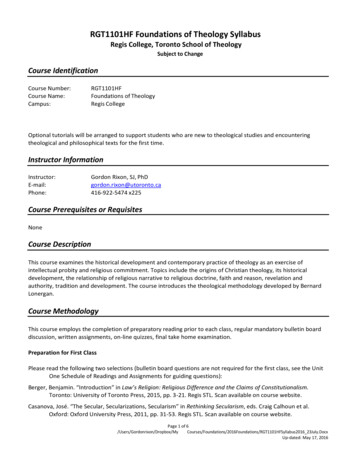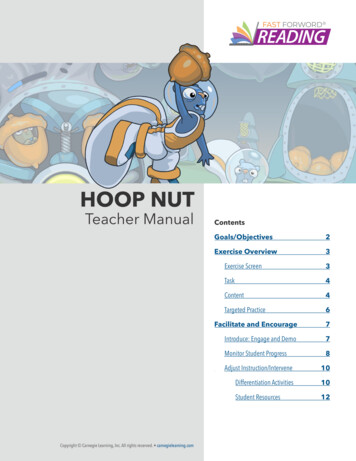
Transcription
HOOP NUTTeacher ManualCopyright Carnegie Learning, Inc. All rights reserved. ise Overview3Exercise Screen3Task4Content4Targeted Practice6Facilitate and Encourage7Introduce: Engage and Demo7Monitor Student Progress8Adjust Instruction/Intervene10Differentiation Activities10Student Resources12
Goals/ObjectivesPhonological Awareness: students will demonstrate understandingof spoken words, syllables, and sounds (phonemes)English LanguageArts Standard(s)Students will be able to. recognize and manipulate units of sound in spoken languagesuch as words, syllables, onset and rime, and phonemes(phonological/phonemic awareness) correctly identify sounds and sound sequences (listeningaccuracy)Language/Reading SkillsStudents will be able to hold a target phoneme in working memory while comparing itto two alternate phonemes to find the matching one (memory) focus on specific information, to sustain that focus, and toignore distractions, while carrying out a task (attention) rapidly interpret and integrate auditory information to identifyphonemes (processing)Cognitive SkillsSocial-Emotional/Executive Function SkillsStudents will be able to. selectively focus and sustain attention on a lesson or an activity inhibit impulsive responses build phonological working memory skills build confidence in listening and phonological awareness skills manage ability to process rapid, complex informationIcon KeyAudio2Hoop Nut Teacher ManualDownloadEnglish LearnerQuick CheckSettingsVideo
Exercise OverviewExercise Screen12376548910121311MenuShows: Time Spent / Time Scheduled for the exercise. Network connection status. Exit: Returns student to the Assignments screen. Continue: Returns student to the exercise.1Current StreakShows the current number of consecutive correct answers in thesession. Resets to zero after an incorrect answer.23 TimeFills in from left to right to show the amount of time spent vs. thetime scheduled for the exercise.4 Feeder MeterTracks and celebrates every 1% of exercise content completion.5 Progress MeterTracks and celebrates every 10% of exercise content completion.Shows actual percent complete for the exercise.6 Highest StreakShows the highest number of consecutive correct answers inthis session.PointsShows total points awarded across all of a day’s sessions. Correct answers: 2 points for each correct answer. Autoplay bonus: double the usual points if all answers in anautoplay set are answered correctly.78 Answer ButtonsThe tokens which must be clicked or moved according to thedirections presented.HelpAllows the student to listen closely to sample questions and takepractice attempts without affecting their progress.9ReplayRepeats the directions to be followed.10Phoneme PairDisplays the phoneme pair the student is currently working on.1112 GoPresents the directions (questions) or a series of Autoplay questions.When an Autoplay sequence is in progress, this counter showshow many questions remain in the sequence.13 AutoplayTurns Autoplay on or off; when on, each click of the Go buttonpresents a series of three or more questions.Hoop Nut Teacher Manual 3
Exercise OverviewTaskWhen the student clicks the Go button, Hoop Nut presents a target syllable, such as /ba/. Next,the acorn on the left moves and plays a syllable. Finally, the acorn on the right moves and playsa syllable. One of the acorns plays the target syllable and the other plays the alternate syllablefor the current phoneme pair. The student must click the acorn that played the target syllable.ContentIn Hoop Nut, the student progresses through 5 phoneme pairs. Each pair presents 2 syllablesthat differ by a single phoneme:Phoneme PairTarget SyllableAlternate Syllable/aba/ /ada//aba//ada//ba/ /da//ba//da//be/ /de//be//de//bi/ /di//bi//di//va/ /fa//va//fa/This exercise provides students with practice differentiating each consonant sound when it isused in combination with a vowel sound.Did you know?In Hoop Nut students are asked to choose between 2 syllables that sound very similar, such as/ba/ and /da/. These types of syllables are called “confusable” pairs. They contain sounds thatcan be difficult to tell apart when the language is unfamiliar, the speaker is unclear, or whenlistening in a noisy environment.Hoop Nut improves students’ ability to rapidly and accurately recognize confusable sounds. Ittrains the brain to act quickly so these sounds aren’t blurred together, which often results in alistener having to ask someone to repeat what they said. Our brains must be able to identifythese sounds to understand what someone is saying. If a sound is perceived clearly in the firstplace, it’s easier to recall it clearly later. Hoop Nut helps students to clearly perceive and representthese easily confusable consonant sounds.4Hoop Nut Teacher Manual
Exercise OverviewProgressionHoop Nut uses synthesized speech with enhanced phonetic features. Initially, the consonantsound in each syllable is highly enhanced, making it easier to perceive the difference betweenthe phonemes. As the student progresses through the exercise, the enhancements are reducedand eventually the syllables are presented in a more natural form. Additionally, the length of timebetween the target and alternative syllables decreases. This pushes the brain to make increasinglyfine distinctions between sounds, and to speed up.Within each phoneme pair, students progress through 26 stages. Hoop Nut adapts to the student’sperformance and will provide targeted interventions if the student is continuously moving amongthe same few stages. To advance to the next stage, the student must answer 3 consecutive questions correctly.If the student answers a question incorrectly, the student moves back one stage. Whenprogressing well, the student may be allowed to skip some stages. When struggling, thestudent may need to work on more of the stages.To complete Hoop Nut, the student must pass all phoneme pairs at the highest stage.Wacky QuestionsTo keep the student engaged and attentive, Hoop Nut occasionally presents “wacky” questions—easy-to-answer questions that provide a fun, unexpected break in the exercise. It includesthe following wacky question pairs, with one syllable/word randomly chosen as the targetsyllable/word:cluck/quack (animal sounds)banana/waffle (spoken words)doorbell/horn (environmental sounds)meow/bark (animal sounds)baa/neigh (animal sounds)Wacky questions do not count toward exercise progression, so the student will not be penalizedfor incorrect answers.Hoop Nut Teacher Manual 5
Exercise OverviewTargeted PracticeThis exercise uses built-in, responsive technology to detect when a student is struggling and administertargeted, inline instruction—right when the student needs it—without any external resources orassistance required. This helps reduce frustration as it quickly gets the student back on track so theycan continue making progress.Hoop Nut provides a variety of inline interventions such as modeling, alternative instructions, andpractice opportunities.The Easy Alternatives intervention uses the same interaction used in the exercise, but with alternativeinstructions and extra feedback. This allows students to learn the task with extra support providedby familiar words that are easy to tell apart (“A” and “B”) and by visual cues on the acorns.Let’s try some differentsounds. Click the acornthat makes the same soundas the Go button.“A”Students get immediate feedback on correct or incorrect answers.Students temporarily stop progressing in the exercise while working through an intervention, thenresume when they return to the regular exercise content.Acoustically Modified SpeechHave you ever worked with a student who had modificationsfor additional think time, extra wait time, or for teachers tospeak more slowly? All of these modifications provide thestudent with extra time to make sense of information, alsoknown as processing time. For students who struggle withprocessing speed, and for those learning a new language,slowing down the rate of speech and emphasizing specificsounds can be very beneficial to develop accurate phonologicalrepresentations, while increasing comprehension.“Whydoes everythingsound so strange?”Fast ForWord’s acoustically modified speech technology(sometimes referred to as “glasses for the ears”) slows andemphasizes speech sounds so that students can hear allsounds in a word. This technology can even stretch outsounds that are physically impossible for human speakersto stretch on their own.6Hoop Nut Teacher ManualSome speech sounds, such as the /b/ sound in the word“bat,” have very fast transitional elements. When we saythem aloud, these elements are easy to miss, but slowingthem and emphasizing them (by presenting them at ahigher volume) helps the brain to hear and respond tothem more quickly.The modified words and syllables in the Fast ForWordexercises may sound strange or mechanical to those whoprocess sounds quickly. But for students who need a littleextra time, the modified sounds and words will be easierto hear than natural speech. As students progress, thestretching and emphasis are reduced, pushing the brainto process at faster and faster rates until it can processnatural speech.Why Does Everything Sound So Strange? (Student)in Student & Teacher ResourcesWhy Fast ForWord Sounds the Way it Does (Teacher)in Student & Teacher Resources
Facilitate and EncourageIntroduceEngageTo introduce the exercise to your students, start by saying: Maybe you have noticed that there are somewords in English that can be difficult or confusing because they sound so much alike, such as bad anddad or bid and did. What are some words that differ by a single consonant that might be hard for you topronounce or understand if someone spoke them unclearly or if you were listening in a noisy environment?For example: bad, dad, fad, had, lad, mad, and so on.Play a “Word Grab” game:1. Write a few words that differ by a single consonant on slips of paper (one word per paper) and givea set to a student or group of students. For example: bid, did, hid, kid, lid, mid, rid2. Put your hand in front of your mouth and call out a word.3. Have students grab the correct word. Keep calling until there are none left.Explain to students that in this exercise they will be listening to pairs of sounds that differ by just onesound (a consonant). Say: The human auditory system can do amazing things when it is well-tuned. Ithas to be well-tuned to understand speech sounds because it has to process more than 700 sounds perminute in typical spoken language! This exercise helps tune your auditory system to quickly distinguish animportant component of many speech sounds: words that differ by just one sound. The sounds presentedare actually phoneme pairs that cover some highly confusable consonant sounds. The object is to listencarefully and determine which of the two sounds you hear matches the first sound presented to you.Demo1. Say: Today, we’re going to practice identifying the syllable that matches a target syllable. Together, we’llwork on an exercise called Hoop Nut. I’ll get us started, then I’d like for you to try.2. Project the “Introduction – English or Spanish demo” for Hoop Nut.3. Follow along with the demo, which explains how the exercise works. One way to help students identify the different syllables is to have them close their eyes while theylisten. Have them say, “First” or “Second” each time they hear first or second syllables. Choose an answer. Correct answer: a “ding” sound effect plays and the astro-nut animates Incorrect answer: a “thunk” sound effect plays4. Demo the keyboard shortcuts: Go button Space bar Left answer Left arrow Right answer Right arrowDirect students to log in and work individually on the Hoop Nut Demo for approximately 10 minutes. Thistime period mimics the timing of the exercise once it’s assigned. Debrief with students to ensure theyunderstand the task and objective of the exercise. Ask: What did you notice? Have students share anythingthat they have questions about.Hoop Nut includes instructional audio for the exercise introduction and instructions. By default,these are presented in English. You can, however, select Spanish instructions for all, some, orindividual students on the Manage page in mySciLEARN.Hoop Nut Teacher Manual 7
Facilitate and EncourageMonitor Student ProgressReview Hoop Nut reports regularly to monitor student progress. Use the data to determine whichstudents are succeeding and which students might be struggling to make progress.Where to look.PROGRESS: Foundations I Exercise Progress - Hoop NutThe colored line showsstudent progress andtheir percent complete.Each dot indicates a daythe student worked onthe exercise.What to look for. what it meansIs the line going up?The student is completing content accurately and makingprogress.Is the line flat across several dots?The student may be struggling and you need to find out why.Are there long lapses between dots?The student may be skipping this exercise.USAGE: Usage Details - ScheduleDo you see half-filled gray circles?The student is working on this exercise, but not meetingthe scheduled time. Make sure that they have time tocomplete their daily schedule. If fatigue is an issue, addsome breaks to their schedule.Do you see red circles?The student is skipping this exercise. Provide support tohelp them re-engage.USAGE: Usage Details - Minutes/QuestionsAre many days highlighted in red?The student is not meeting their daily schedule. Checkthe Schedule tab in this report to investigate further.Is the student answering fewer questions than usual?They may be distracted or losing focus. In comparison totheir previous activity, a low number of trials to minutesmay indicate the student is not applying themselves tothe task.Is the student answering more questions than usual?They may be rushing. In comparison to their previousactivity, a high number of questions to minutes mayindicate that the student is trying to amass points orprogress through the content without actually learning it.Ask them to turn Autoplay off. Remind them that makingprogress depends on accuracy, not speed.8Hoop Nut Teacher Manual
Facilitate and EncourageWhere to look.PROGRESS: Progress Details - Hoop Nut ProgressQuestionsTypical range for students making good progress: Phoneme Pair /aba/ /ada/: 50 - 100 Phoneme Pair /ba/ /da/: 50 - 100 Phoneme Pair /be/ /de/: 50 - 100 Phoneme Pair /bi/ /di/: 50 - 100 Phoneme Pair /va/ /fa/: 50 - 100What to look for. what it meansHas the student answered too many questions withoutpassing a level?Each phoneme pair includes a minimum of 48 questions. Most students should be able to complete a level in under100 questions. A student who is still working on a level after more than 125150 questions may be struggling. If a student has answered more than 150 questions, make surethe student remains attentive and motivated. Any increase ina student’s chart shows that the student is making progress.Celebrate these improvements, however small they may seem.See the “Adjust Instruction/Intervene” section in this teachermanual for suggestions on supporting struggling students.Foundations I Progress Monitoring Chart in Student & Teacher ResourcesHoop Nut Teacher Manual 9
Facilitate and EncourageAdjust Instruction/InterveneDifferentiation ActivitiesDifferentiating instruction requires continually striving to know and to respond to each student’sneeds in order to maximize learning. Use the data in Hoop Nut reports to adjust instruction tomeet each student’s needs and respond to variance among learners. The activities below aresuggestions to support students who might be struggling with their progress in Hoop Nut.Does the student understand the exercise goal/task?If necessary, demonstrate how the exercise works by using your hands to simulatethe acorns on the screen.1. Hold up your closed hands with your palms facing the student.2. Say /bah/ without opening either hand.3. Next, say /dah/ while briefly opening then closing your right hand.4. Finally, say /bah/ while briefly opening then closing your left hand.5. Ask the student to point to the hand that opened when you repeated /bah/.Try this a few times, changing which hand you open when you repeat the target syllable.Have the student explain back to you what they need to do to get a correct answer.Can the student hear the syllables clearly?Check the headset, volume controls, and background noise level.Is the student staying focused on the task?Discuss the importance of not making errors. Provide a challenge to pique interest,or strategies to support attention.This task puts heavy demands on sustained attention, so students may benefit fromtaking periodic brain-breaks or turning off Autoplay.10Hoop Nut Teacher Manual
Facilitate and EncourageDoes the student struggle to stay engaged?Emphasize the importance of streaks—the highest number of correct responses in arow. Have the student use the Foundations I Streaks and Completion Chart to tracktheir highest streaks and review to see which days were higher or lower. Encouragethe student to self-monitor and improve their accuracy. The sooner they completethe exercise the sooner they can move forward to something new.Is the student aware that this exercise uses the 3-Forward/1-Back Rule to makeforward progress?Is the student aware that this exercise uses the 3-Forward/1-Back Rule to make forwardprogress?Explain that accuracy is the key to moving through the content in this exercise. Studentsmake progress based on the 3-Forward/1-Back Rule: they move forward when theyget 3 answers in a row correct, but they move back when they get 1 answer incorrect.Because streaks record the number of correct answers in a row, charting this canhelp the student self-monitor by providing visual feedback of their number of correctanswers in a row. Students can use the Three-in-a-Row Worksheet.Can the student hear the difference between the syllables?Hold your hand over your mouth to slightly muffle the sound and have the studentidentify whether you are saying /ba/ or /da/, /be/ or /de/, /va/ or /fa/. If the student ishaving problems, continuing on with this exercise will help them. Their struggle nowwill pay off later!Does the student hear something different than what is shown on the screen?At early speech processing levels, what the student hears may seem different fromwhat they see on the screen (the syllables written near the Go button). For example,they may see “ba da” but hear something that sounds like /ra/ /ya/. This is OK. Reassurethe student that the exercise is working correctly. Have the student focus on listeningto and remembering the first syllable they hear, and then identifying its match in thenext two syllables they hear.Hoop Nut Teacher Manual 11
Facilitate and EncourageAdjust Instruction/InterveneStudent ResourcesYou may decide to use any or all of these monitoring sheets with your students:Three-in-a-Row Worksheet in Student & Teacher ResourcesExplain to students that accuracy is the key to moving through the content in this exercise.Students make progress based on the 3-Forward/1-Back Rule: they move forward whenthey get 3 answers in a row correct, but, they move backward when they get 1 answerincorrect. Because streaks record the number of correct answers in a row, this sheet canhelp students self-monitor for correct answers by providing the visual feedback thatsome students need to register their number of correct answers in a row. This sheet isuseful for daily monitoring. Students will likely need one copy per day.Foundations I Streaks & Completion Chart in Student & Teacher ResourcesExplain to students that accuracy is the key to moving through the content in Fast ForWord.Because streaks record the number of correct answers in a row, this chart can help studentsself-monitor for accuracy. After they complete their exercises for each day, have studentsrecord their highest streaks and percent complete in each exercise, then challengethem to exceed those numbers tomorrow. Students will need one copy every 5 days.Foundations I Completion Chart in Student & Teacher ResourcesStudents can self-monitor their progress in each Foundations I exercise by filling in the bareach day with their actual completed percentage. This provides students with an overallview of how much content they’ve completed compared to how much they have left todo. Students will need one copy.12Hoop Nut Teacher Manual
sound (a consonant). Say: The human auditory system can do amazing things when it is well-tuned. It has to be well-tuned to understand speech sounds because it has to process more than 700 sounds per minute in typical spoken language! This exercise



